“So a complete 100
Ahmet Uzumcu, Director General of the OPCW, 2016percent chain of custody is absolutely critical.”
Date of Report: October 5, 2019
Introduction
In this report, I take a look at the OPCW and their own requirements for “full chain of custody”
Having carried out in-depth research into the OPCW and their various Syrian investigations I had begun to notice a move away from their own stringent founding principles to a more relaxed, laissez-faire, approach as they contracted out their on-the-ground investigations to a side in a war that had vested interests in the outcome of such investigations.
In this report, I will show you the original position the OPCW took back in 2013 to the position they began to adopt just a few short years later.
What is a CWC – Chain of Custody?
I made enquiries into the specific requirements from the CWC (Chemical Weapons Convention) on the importance of the Chain of Custody for OPCW investigations and was forwarded a copy of Dr Markku Mesilaakso’s “Chemical Weapons Convention Chemicals Analysis:” book (ISBN-9780470854259) from a reporter at the Washington Post. In the book he defines the CWC’s Chain of Custody requirements as the following:
Chain-of-custody procedures are followed to guarantee
Page 45: Chemical Weapons Convention Chemicals Analysis; Mesilaakso, Markku, 2005
the integrity and confidentiality of sample
material during its lifetime from the collection of
the sample up to its destruction.
A sample is under OPCW custody, if
– it is in the physical possession of an OPCW
staff member;
– it is in the view of an OPCW staff member after
having been in his/her physical possession;
– it has been in the physical possession of an
OPCW staff member and placed by him/her in
a designated and identified secured area sealed
with an OPCWtamper proof seal.
He goes on:
During transport, OPCW custody of samples is
Page 45: Chemical Weapons Convention Chemicals Analysis; Mesilaakso, Markku, 2005
maintained by the OPCW seals (fibre optical, frangible)
on the primary, secondary, and intermediate
packaging containers. The integrity of these seals
ensures the integrity of the samples in regard to
tampering.
Movements of samples are performed in a controlled
and documented manner, which will enable the
life history of each sample or portion thereof to be
tracked. This is achieved by means of appropriate
documentation (see below) and the presence of an
OPCW representative to escort samples to the extent
possible during transport. The information contained
on the shipping documentation must be limited to the
minimum information necessary for the transfer of
samples and as required by the respective transport
regulations.
Note, these are not conditions set by the OPCW but by the CWC in which the OPCW must adhere to. They are bound by the Convention’s rules.
Markku goes on:
-At the beginning of an inspection, an individual
Page 46: Chemical Weapons Convention Chemicals Analysis; Mesilaakso, Markku, 2005
inspection notebook is issued to each
IT member. The inspector must record all
information gathered during the inspection
preparation phase and on-site activities in
his/her inspection notebook. The notebooks
never leave the custody of the IT.
– All activities and conditions regarding sampling,
sample splitting, sample preparation, analysis,
and destruction of sample material on-site
are documented in the OPCW Sampling and
Analysis Booklet. One booklet is used for each
authentic or background sample collected on
site. Sample code of the authentic sample and
seal numbers of the authentic and the split
samples are recorded in this booklet. Each page
filled in the booklet is authenticated by the
inspector(s) performing the task and offered to
the ISP representative witnessing the activity to
confirm it with his/her signature. The booklet
is closed when all on-site activities concerning
the respective sampleare finalized. The booklet
never leaves the custody of the IT; it is part of
the on-site analysis report (see below) and as
suchhand carried from the inspection site to
the OPCW Technical Secretariat.
– All documents related to and created during onsite
sampling, sample splitting, sample preparation,
and analysis are attached to the on-site
analysis report (see below). The on-site analysisreport is part of the report created by
the IT concerning the inspection activities and
subject to the same confidentiality regime as
the report itself. Under no circumstances are
any of these documents sent together with
samples off-site. The on-site analysis report
has to provide data to validate the method as
well as the analysisresult in accordance with
OPCW procedures and the Quality System
requirements.
I have reproduced that section of the book as it was written.
The reporter (no supporter of the Syrian government) who entered into communication with me on the subject matter requested I not mention their name yet gave me permission to quote them. I have decided against doing so as on a personal basis, I don’t trust or believe ‘anonymous sources’. I did, however, thank them for their time and information.
Khan Sheikhoun Chain of Custody
58. The munition remnants recovered from the crater by unidentified individuals are assessed as being associated with an air-delivered chemical bomb. Specific munition remnants, particularly the tailfin, could not be recovered. The absence of a chain of custody relating to the munition remnants diminishes their probative value.
Page 28: S/2017/904 ; Joint Investigative Mechanism Report into Khan Sheikhoun
So the remnants found at Khan Sheikhoun, having never reached either the OPCW-FFM or JIM, were “assessed as being associated with an air-delivered chemical bomb.” Here the OPCW broke with their own rules on Chain of Custody and even noted the same in the final sentence:
The absence of a chain of custody relating to the munition remnants diminishes their probative value.
Yet this didn’t stop them from concluding:
On the basis of the foregoing, the Leadership Panel is confident that the Syrian Arab Republic is responsible for the release of sarin at Khan Shaykhun on 4 April 2017. The findings of the Leadership Panel regarding the evidence in this case are based on the information set forth in detail in the present annex.
Page 33: S/2017/904 ; Joint Investigative Mechanism Report into Khan Sheikhoun
“Key Objectives for OPCW Sampling and Analysis:”
1. Sample Authenticity: Place and time of collection, splitting, sealing,
chain of custody2.
Validity of Sample treatment: validation of sample preparation procedures, detailed documentation, nocross contamination 3. Correctness of analysis results: validation of method, instrument performance, no
Emphasis OPCW’s. Sliwakowski, Maciej; OPCW Laboratory; 2010cross contamination , NO FALSE POSITIVES
Note, in the above three OPCW rules on sampling and analysis there is a strong demand on samples being ‘split’ to prevent “
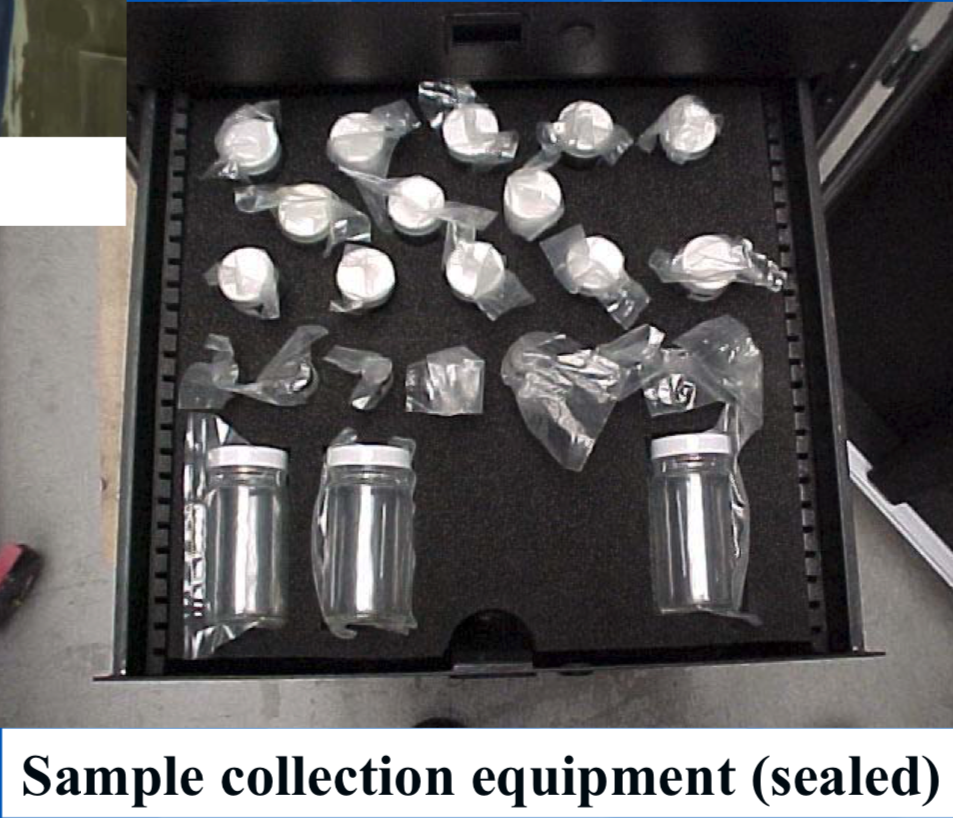
There must be an unbroken chain of evidence linking each test sample to each reported chemical.
Emphasis OPCW.
Al-Lataminah Chain of Custody
There wasn’t any chain of custody that we know of from either the FFM or White Helmets with regards any of the samples or debris collected at Lataminah. What we know is that some samples were handed to the FFM on the 12 April 2017 and the remainder on 17 & 18 July 2017.
They were collected and placed into these cases:

Here you will such cases laid out in a field near the “Crater”:

This is a breakdown of what was in one of the cases from the 17 July 2017 as presented to the FFM:
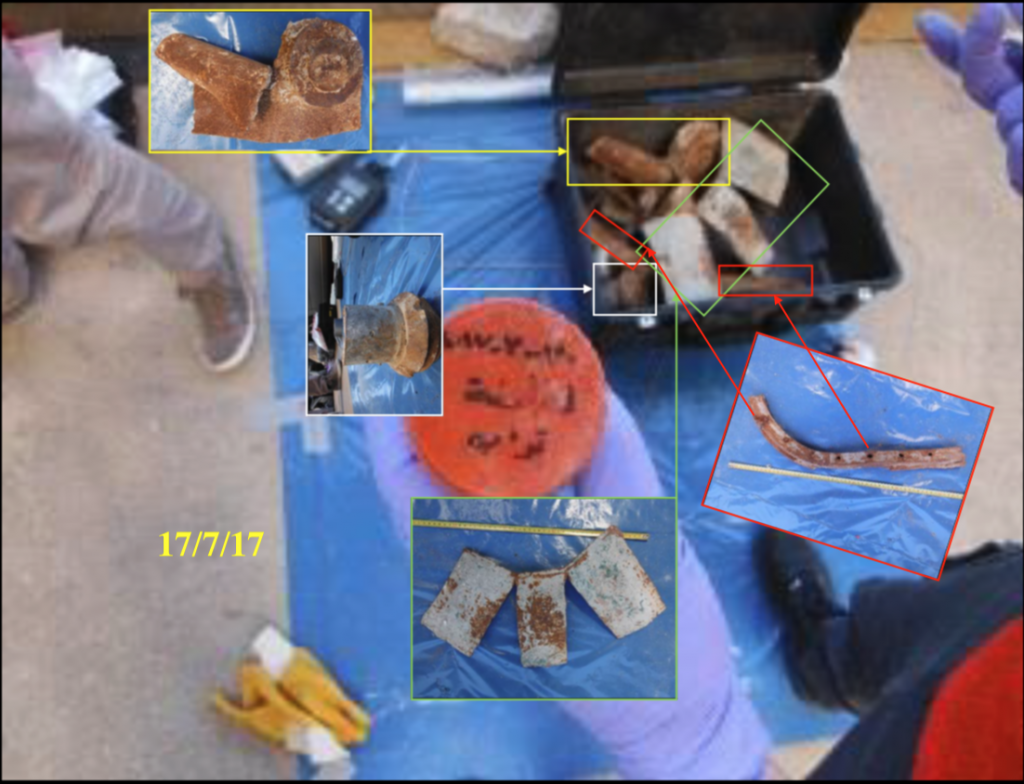
Now, let’s remind ourselves of the “Key Objectives for OPCW Sampling” again:
1. Sample Authenticity: Place and time of collection, splitting, sealing, chain of custody
2. Validity of Sample treatment: validation of sample preparation procedures, detailed documentation, no cross contamination
3. Correctness of analysis results: validation of method, instrument performance, no cross contamination, NO FALSE POSITIVES
All of these pieces tested positive for sarin and/or degradation products.
Remember also that this “Hazmat team” are the team the FFM refers to as the “SCD Chemical Sample Unit” yet the FFM nor JIM makes any reference to this team wearing training suits that I established were not fit for purpose, being long out of date and also damaged. I mention this as the competency of this ‘specialist unit’ is highly suspect, at best, as I have
However, the JIM did question how the White Helmets “Chemical Sample Unit” were able to ascertain that sarin had been used in Khan Sheikhoun using methods and equipment that are unable to detect sarin:

And as mentioned before, some munition remnants made their first appearances into the evidence bank on the 18 July 2017, having not been noted or recorded anywhere previous to that date. Recall, the Lataminah event allegedly took place on the 30 March 2017!
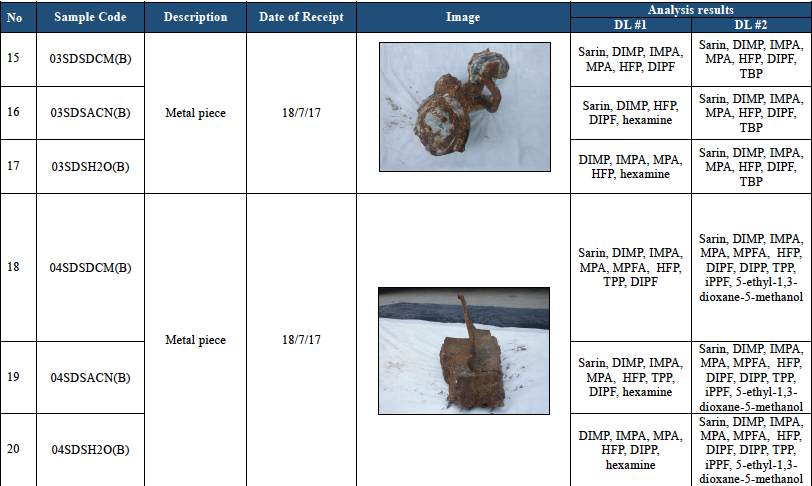
The infamous filler cap with lug and a piece of, what is thought to be, ballast from the nose cone. Both pieces tested positive for sarin. Both pieces came into being on the 18th July 2017.
Chain of custody? None. Recorded movements, locations of finds or storage details added? None. They just appeared from nowhere, it seems, and given the lack of OPCW curiosity about their whereabouts or history, I find that alarming.
OPCW – Importance of Chain of Custody: In Their Own Words
Scott Cairns was the Deputy Head of Mission for the UN Mission in Syria and the Team Leader of the disarmament group that oversaw the destruction of Syria’s chemical arsenal. Here is Cairns speaking about the necessity of a Chain of Custody and why it’s so important:
After watching that video one could be forgiven for coming away from it feeling like the OPCW that Cairns is speaking about and the OPCW that investigated Khan Sheikhoun and Al-Lataminah are two very different entities. But maybe there were/are?
George Monbiot on the OPCW Coup
In 2017, the UK Guardian reporter, George Monbiot, wrote an opinion piece on the Guardian entitled:
A lesson from Syria: it’s crucial not to fuel far-right conspiracy theories
In the article Monbiot accepts, unquestionably, the conclusions of the OPCW;
that the atrocity was caused by a bomb filled with sarin, dropped by the government of Syria.
George informs us that we should not “fuel far-right conspiracy theories” by questioning the OPCW conclusions. George spends a lot of his time attacking and labelling all and any who question the official Khan Sheikhoun narrative – indeed anyone who questions the official UK position on Syria. Full stop.
Notwithstanding the fact I have shown that the real conspiracy theory regarding Khan Sheikhoun is the official narrative what George’s opinion piece does is show the power that cognitive dissonance can have over a person. George, who doesn’t have a technical argument himself on what happened at Khan Sheikhoun, employs heavy doses of argumentum ad verecundiam as he goes through a list of notable persons who questioned the official narrative and derides them each individually. Their crime, it seems, is/was to question the trustworthiness of the OPCW and Monbiot, as the self-appointed adjudactor of the truth on this matter, decided they weren’t going to get away it.
That’s a rather odd and, to be blunt, extremely hypocritical position for George to take given that it was he who was first to allege that,
the US government [was launching] an international coup [against the OPCW]
George goes on to tell the reader the US was,
seeking to overthrow 60 years of multilateralism, in favour of a global regime built on force.
What he’s referring to was then Director-General of the OPCW, Jose Bustani who was forcibly ousted from his role as DG by the US. George was right about that. He goes on:
In January, with no prior warning or explanation, the US State Department asked the Brazilian government to recall him, on the grounds that it did not like his “management style”. This request directly contravenes the Chemical Weapons Convention, which states “the Director-General … shall not seek or receive instructions from any government.” Brazil refused. In March, the US government accused Bustani of “financial mismanagement”, “demoralization” of his staff, “bias” and “ill-considered initiatives”. It warned that if he wanted to avoid damage to his reputation, he must resign.
Again, the US was trampling the convention, which insists that member states shall “not seek to influence” the staff. He refused to go. On March 19th, the US proposed a vote of no-confidence in Mr Bustani. It lost. So it then did something unprecedented in the history of multilateral diplomacy. It called a “special session” of the member states to oust him. The session begins on Sunday. And this time the US is likely to get what it wants.
The US did get what it wanted an Bustani was ousted.
George’s most powerful claim comes towards the end of his 2002 article:
If it wins, then the OPCW, like UNSCOM, will be fatally compromised. Success for the United States on Sunday would threaten the independence of every multilateral body.
Emphasis mine.
The US did win.
17 years have very much changed George and his world view, it would seem. From leading the pack in conspiracy theories to policing those he now claims are conspiracy theorists is nothing short of fantastic revisionism.
George tells us in 2002 that the OPCW became “fatally compromised” by the US coup. He never tells us when this came to an end; how this came to an end; and how he knows it did. He jumps from one extreme to the other. From claiming the OPCW was hijacked by the US to lambasting anyone who claims the OPCW has been hijacked by the US as “conspiracy theorists”.
What happened to George and when he decided to become gatekeeper over the very much discredited Khan Sheikhoun “official narrative” (that incidentally is supported by al-Nusra (HTS/al-Qaeda) we don’t know. But we do know is he once espoused the idea the OPCW leadership had been captured by the US.
Conclusion
So, if even the Syrian’s accept that sarin was used at Khan Sheikhoun then how important is a chain of custody in this instance?
Arguably, rules are rules and cannot be implemented on some occasions and ignored in others. In carrying out an investigation, when both sides agree on something as important as the use of sarin, it still isn’t acceptable to ignore your own guidelines, as this leaves you open to charges of sloppiness and bias. Indeed, there are some that believe sarin wasn’t used at all in Khan Sheikhoun and that samples were taken to Turkey where they then were contaminated. At this stage, some samples were sent to the FFM whilst others were sent to the Syrian government, via its own source. I don’t support that
Then there are the alleged munition remnants found at the crater in Khan Sheikhoun that never made it into the hands of the FFM or JIM teams. Instead, the filler cap went to Human Rights Watch where it was then “assessed” and results sent on to the JIM whilst the “cylindrical piece”, or “flattened metal piece”, that protruded from the crater seems to have been buried in said crater and covered with concrete.
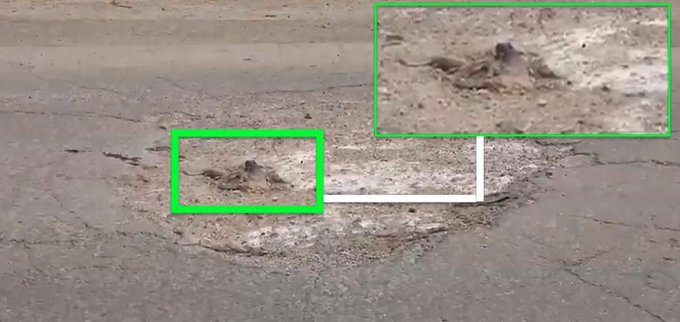
What of the “metal rail”? Nobody knows and even less seem interested. Yet this vital piece of evidence just vanished almost as quick as the ‘filler cap with lug’ appeared!
Then we have this piece that was allegedly recovered from the “impact site” at Lataminah on the 30 March 2017:
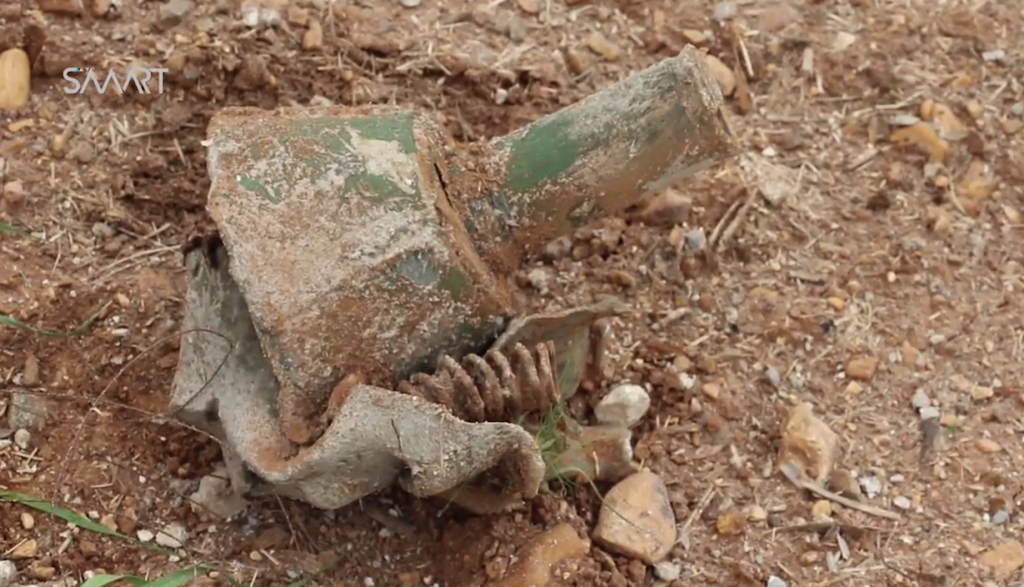
Is was recorded on video as being recovered from the site but seemingly never made it to the FFM and if it did, it was never mentioned in their report.
This remnant just disappeared too! A chain of custody would have ensured all pieces made it back to the OPCW labs for a full analysis.
What actual proof have we got that sarin was unleashed at this impact site in Lataminah and that the samples and remnants weren’t contaminated elsewhere? Given several oddities in the recovery spots of alleged remnants such as the “impact fuse” (a fuse that requires an impact…obviously) being recovered ≈30m away from the site of impact and in front of “mixing arm” when you’d assume the mixing arm would have fallen close to the tail fin. Then there’s the small matter of the remnants not being collected by the White Helmets until the 5th July 2017, ≈13wks post-event, thus apparently laying at the spots they allegedly landed at all this time.

Along with missing remnants that never made it to the FFM and moving remnants that are recorded landing at several different spots, there’s a pretty good case to be made that all is not what it may seem at Al-Lataminah. An onsite investigation and a
Most curiously of all, in my opinion, is the matter of sarin being found in several different spots, according to the FFM.
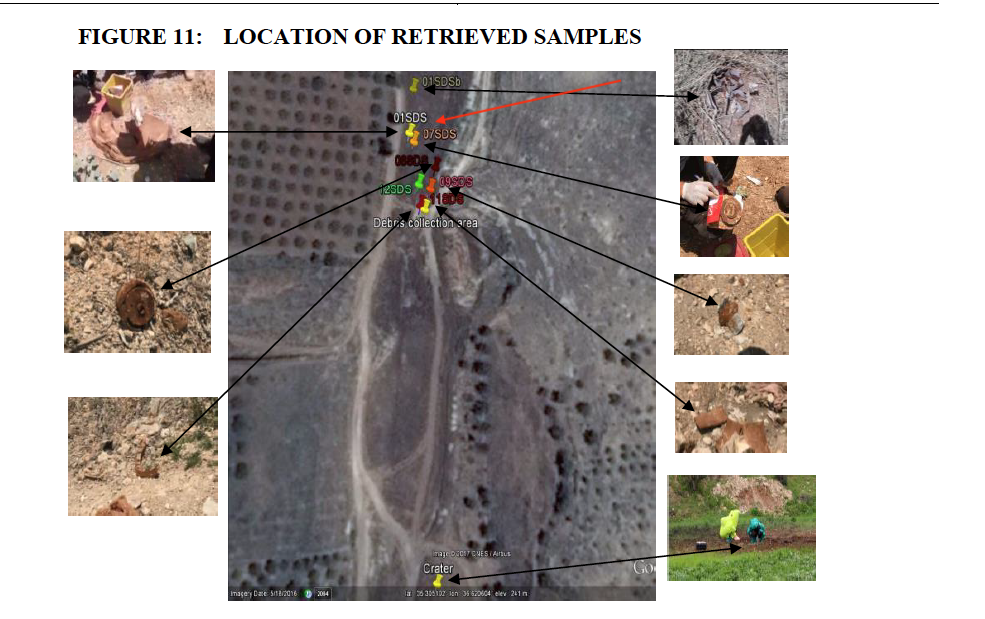
I believe the alleged impact location to have been around the spot suggested by my red arrow (top). The various markers were placed on the map by the FFM denoting were they believe the remnants were recovered.
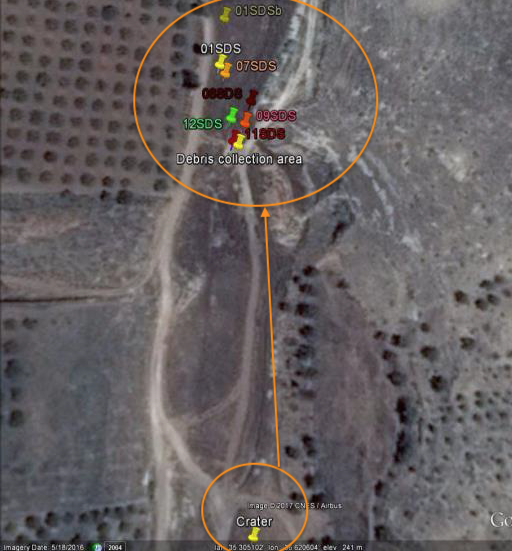
Further south we have a location denoted in the FFM report as “Crater”. Gravel taken from this spot and 50 yards from it both tested positive for sarin:
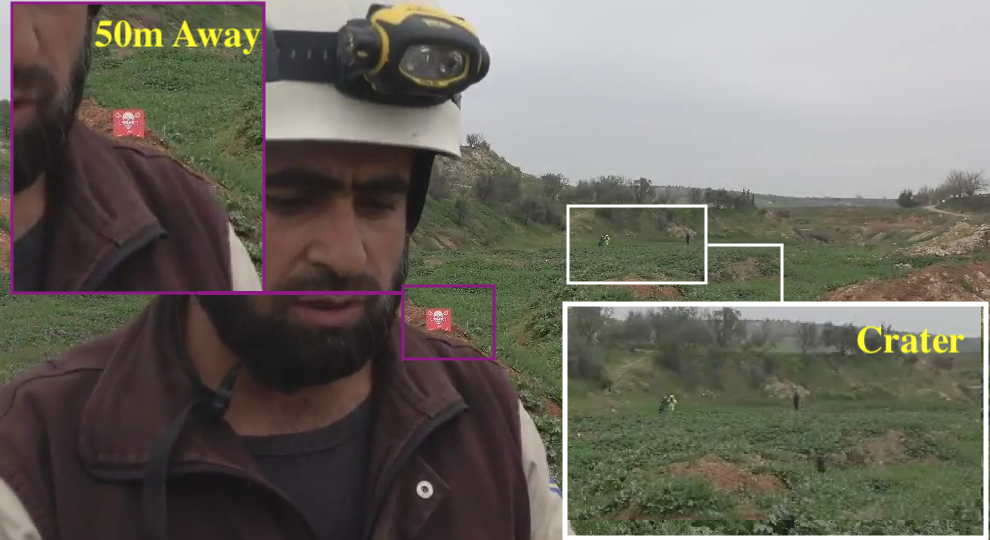

Yet we have no explanation on how this could have happened. Given that only one bomb is alleged to have contained sarin and no bomb fragments were alleged to have been recovered from this spot then I suggest some genuine suspicions surrounding these two separate finds arises – that have never been addressed.
But what if these samples fell victim of cross-contamination themselves? Is there evidence this could have occurred? This is a screenshot I took from the video of the White Helmet sample collections. Note that
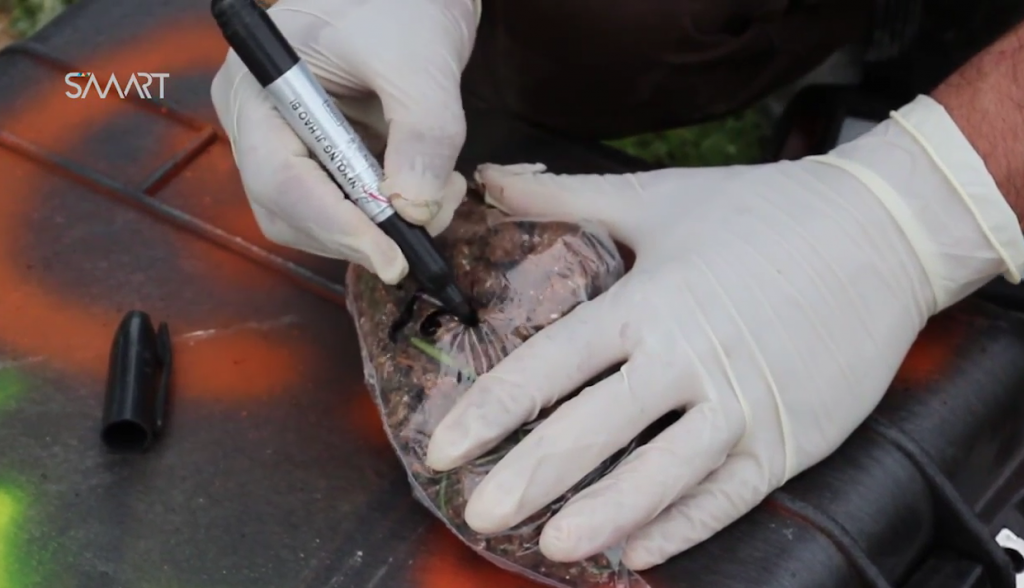
Here are the samples being received by the FFM:
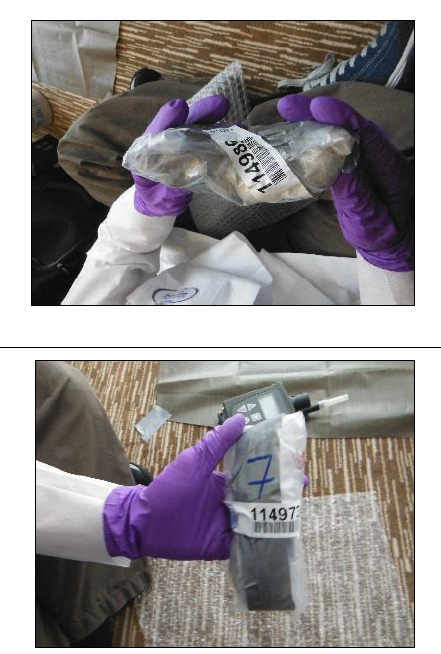
So it’s very unlikely cross-contamination could occur from onsite sealed, gravel samples. The bags in the hands of the FFM look thicker than the ones in the hands of the White Helmets. It appears the FFM may have placed an outer bag over the samples and labelled them with a barcode sticker.
Either way, the “crater” samples were bagged thus cross-contamination seems unlikely. As said, they both tested positive for sarin. How?
A full chain of custody over these samples would have ruled out possible staging scenarios which, in the absence of evidence of a dispersal method at the “Crater”, seems a likelihood in this instance.
So the importance of chain of custody for OPCW investigations is something that cannot be set to the side or sub-contracted out to an actor in a war. There are just too many discrepancies and oddities to be written off as ‘poor administration’ in these White Helmet chemical investigations. Too many suspicions arise when you invite a vested interest to be placed in charge of evidence collecting against their opponent.
Something clearly changed in the way the OPCW carried out their investigations under people like Scott Cairns to what occurred at Douma, Khan Sheikhoun and Al-Lataminah. Whilst at Douma the OPCW went on-site and collected evidence themselves as we have now been made aware via a leaked FFM sub-team document that appears to have been suppressed, that the OPCW ignored their own engineering team’s assessment in favour of that of
What we can say at this stage is that the OPCW Syrian investigations, over the past few years, are anything but thorough, unbiased and transparent.
I will end on a quote from Ake Sellstrom. He was the UN lead into the 2013 Ghouta sarin incident:

